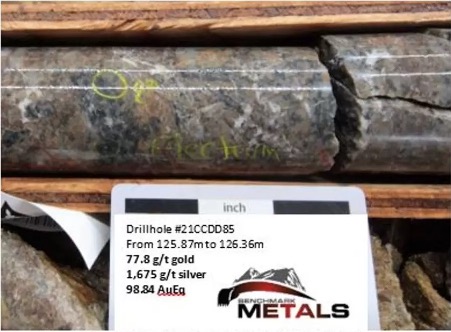Benchmark Metals Inc.(TSXV: BNCH) (OTCQX: BNCHF) advanced metallurgical laboratory test results for the company’s 100% owned Lawyers gold-silver Project, located in north-central British Columbia (BC), Canada.
The testwork has provided gold leach recoveries averaging 93%, and silver recoveries of approximately 65% from the Amethyst Gold Breccia (AGB) and Cliffs Creek resources.
The company said the advanced testwork confirms a simple preliminary design using conventional whole rock cyanide leaching and incorporating Merrill Crowe zinc precipitation to produce on-site gold and silver Dore.
The test work builds a large data set throughout the main Amethyst Gold Breccia (AGB) and Cliffs Creek resource areas, in addition to composites representing potentially the first years of mining in a conceptual mine plan. The Lawyers Project is located in the historic mining region of the Golden Horseshoe.
“The results demonstrate exceptional gold recovery from rocks utilising a conventional and proven method that results in pouring gold and silver Dore bars. Technical results and participation from miners like Yamana Gold in Benchmark Metals continues to validate the potential to become Canada’s next major gold and silver mine,” President and Director, Jim Greig, said.
VP Engineering, Ian Harris, said the company is very encouraged by the metallurgical test results that demonstrate robust recovery on a standard conceptual mining schedule and support using a straightforward, proven, industry norm, processing flow sheet.
“The growing data set is now incorporated into our modelling and supportive of the evaluation of multiple mining scenarios for future feasibility level evaluations.”
The metallurgical programme was advanced and coordinated by F. Wright Consulting Inc., under the direction of Frank Wright, P. Eng. Mr. Wright is an independent metallurgical consultant, with extensive experience in precious and base metal process development. He is the qualified person as defined by National Instrument 43-101.
The supporting studies have been conducted by several globally recognized laboratories including:
- ALS Laboratory – Kamloops, BC: for detailed comminution testing;
- BV Mineral Process Laboratories – Richmond, BC: for optimisation and variability gravity treatment and bottle roll leaching studies;
- FLSmidth Inc. – Salt Lake City, Utah: for leach response confirmation, gravity pre-treatment, and filtration test work, and;
- SGS Mineral Services – Lakefield, Ontario: for treatment circuit simulation for the leach process, liquid/solid separation, and Merrill Crowe.
Various mineralogical studies have also been performed on AGB and Cliffs Creek samples that indicate the gold is primarily present as fine native particles.
Depending on the sample specimen, the silver occurs predominantly as acanathite (Ag2S), or electrum, often as coarser particles of 200 microns or greater, although it can be fine grained as well. To a lesser extent native silver is present.
Metallurgical Testing Results
The recent laboratory studies suggest processing by grinding to a targeted feed particle size 80% passing (P80) range of 106 to 125 microns, incorporating gravity pretreatment by centrifugal concentration, followed by conventional cyanide leaching of the gravity tailing.
These moderate operating conditions provide excellent gold recoveries, that consistently exceed 90%. The majority of the gold is yielded within 24 hours of leach retention time. More intensive treatment procedures provide minimal improvement to the overall gold recovery.
As is typical for this type of mineralisation the silver leach dissolution is more challenged, averaging approximately 65%. Generally higher silver recovery occurs in the Cliffs Creek Zone, as compared to AGB.
The silver recovery benefited from an additional 12 hours of leach retention time, along with elevated sodium cyanide (NaCN) addition and increased pH (with lime). Additional more aggressive procedures such as use of lead nitrate, oxygen, finer grinding, further lixiviant, and elevated caustic can offer some limited further improvement to silver recovery.
However, the more aggressive treatment procedures were not deemed to be economically beneficial at this time. Further optimisation of silver recovery will be undertaken in the future as mill head grade and metal pricing accuracy improve towards more detailed economic evaluation.
These reported test results are additional to prior optimization testing, and to preliminary data previously reported in June 2021. The following Table provides a summary of the most recent bottle roll data obtained under ambient conditions, with 36 hours of leach retention time at 40 wt.% solids, and pH~11.
This recently completed laboratory programme consists of a further 40 variability samples conducted on AGB zone, and 25 variability samples from the Cliffs Creek zone. The variability samples originate from drill core assay rejects composited in length to each represent potential mining bench heights of ~10 m.












